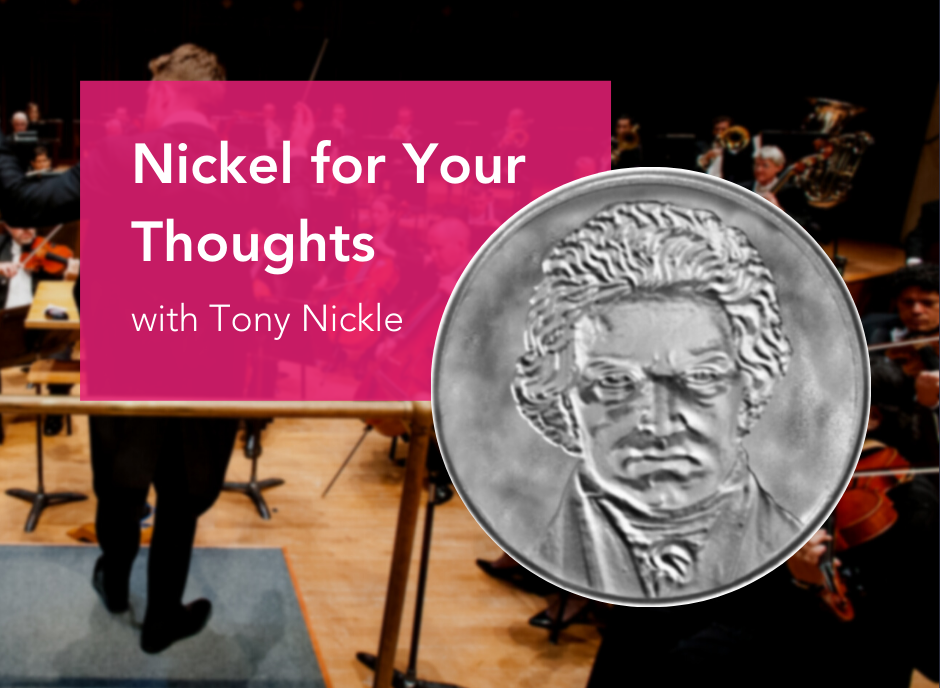In his own words, Vice President & Artistic Administrator Tony Nickle shares what he believes to be the high points of the program, but with a little edge and humor for good measure.
Welcome back, everyone! We are incredibly excited to be back with what I think is our most exciting season since I arrived nearly six years ago. It’s a season full of the names we know while still championing living composers who keep our art form moving forward, world-class guest artists, and a production of La Bohème that is going to knock your socks off.
Our opening weekend features the Mantle and Ruth of the symphony orchestra world: Mozart and Beethoven. And, we’re kicking off our season-long David M. Hicks Mozart Piano Series on our brand-new Steinway concert grand, made possible by the generosity of Ann Hicks in David’s honor. Courtney Lewis, Steven Libman and I visited the Steinway Factory in Astoria, Queens in late July to select the instrument. We also brought in two experts to help us in our selection: star pianist Natasha Paremski, and the lead piano technician from both Juilliard and the Tanglewood Festival, Steve Carver. Incidentally, Steve was the piano technician at the University of Iowa many moons ago when I was a graduate student in piano performance, and it was wonderful to see him again after many years. We took a tour of this legendary factory where all pianos are made by hand (not on assembly lines), and the concert grand models (9 feet in length) take nearly a year from start to finish. This means that no two Steinways are identical in terms of feel and sound, which is one of the most wonderful (and sometimes challenging) aspects of the brand that more than 90 percent of concert pianists in the world choose.
Following the tour, we moved to the selection process: five new concert grands lined up in a row in a small showroom. We knew within two or three minutes that two of the pianos stood out from the rest, and it was evident soon thereafter that one had the most special voice of all. Natasha spent the next 45 minutes going back and forth between the top two candidates just to be sure, but in the end the winner was a clear choice to everyone in the room. Of course, Courtney and I spent some time playing the instruments just for fun; it isn’t every day you get to have a play date with five brand new Steinways. To say this checked a major bucket list experience would be an understatement.
Later that evening we all went for a celebratory dinner at this fantastic Russian restaurant near Gramercy Park called Mari Vanna. Definitely a thumbs up.
On to the music for this weekend. Mozart’s D minor Piano Concerto is full of moments that hint at the drama and individualism of German Romanticism, even though music that squarely belongs to that era is at least two decades away. The orchestral exposition tells you from the very first notes that you are in for a very personal journey. For me, the first movement portends some of the brooding drama that Mozart incorporates into Don Giovanni only two years later. The second movement could hardly be a more introspective and gentle respite. The third and final movement is oscillates between a restless and foreboding theme and one that is bright and sunny. Near the end, following an extended cadenza in the piano, the coda breaks into the major theme that finishes with a joyous conclusion. The piece itself may not belong in the Romantic Era, but that dramatic arc sure does.
We’re thrilled to have the young and brilliant pianist, Daniel Hsu, joining us for this masterpiece. Daniel was a medalist at the 2017 Van Cliburn Piano Competition, which is arguably the top piano competition in the world these days. Don’t miss the chance to come hear this pianist who may someday be a household name.
Picking up on Mozart’s anticipation of the Romantic Era, Beethoven’s First Symphony is also full of forward-looking ideas; I’ll focus on one in particular. When Beethoven wrote this in the late 1790s, it was typical to let the audience know what key we were going to be in right from the start. Well, Beethoven wasn’t much for rules, and he demonstrates that right from the top with a series of cadential chords that eventually land us in G major throughout a brief but slow introduction (a device Haydn and Mozart both used in first movements). But just when we’ve settled in for a ride in G major, we cadence into the actual key for the first movement: C major. Beethoven keeps his audience in limbo for more than a minute before we know where we really are, and that would likely have been mind boggling to his Viennese audiences around the turn of the 19th century.
Looking ahead, we are performing five of Mozart’s finest piano concertos this season, which is saying something because I would argue that Mozart’s piano concertos represent some of his most incredible and innovative compositions. Each of these five were written between 1785 and 1786 (between the ages of 29 and 30), and every one is utterly unique in character. You won’t want to miss any of these gems this season, especially considering the outstanding lineup of pianists we have.
I hope to see you all in Jacoby Symphony Hall this weekend. Cheers to a new season!
Learn more about the Mozart’s Romantic Side performances here.
By Tony Nickle, Vice President & Artistic Administrator


